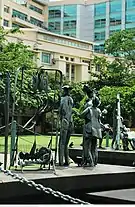Far Eastern University
Far Eastern University (Filipino: Pamantasan ng Malayong Silangan), also known simply as FEU, is a private university in Manila, Philippines. Created by the merger of Far Eastern College and the Institute of Accounts Business and Finance, FEU became a university in 1934 under the guidance of its first president, Nicanor Reyes Sr.[2] It has been noted as the leading proprietary university in the Philippines.

Pamantasan ng Malayong Silangan | |
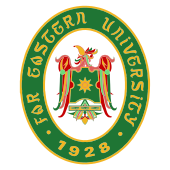 | |
Former names | Far Eastern College (1919–1922) Institute of Accountancy (1928–1929) Institute of Accounts, Business and Finance (1929–present) |
|---|---|
| Motto | Be Brave |
| Type | Private coeducational research university |
| Established | June 1, 1928 (92 years and 253 days) |
| Founder | Nicanor B. Reyes Sr. |
Academic affiliations | |
| Chairman | Aurelio Reyes Montinola III |
| President | Michael M. Alba |
| Vice-president | Maria Teresa P. Tinio |
Academic staff | 1500 |
| Undergraduates | 39,361 including subsidiaries[1] |
| Address | Nicanor Reyes Street, Sampaloc, 1015 , , , 14°36′14″N 120°59′08″E |
| Campus | Main campus FEU Manila 4 hectares (9.9 acres) (40,000 m²) Satellite campus |
| Colors | Green and Gold |
| Athletics | Varsity teams
|
Sporting affiliations | |
| Sports | See list |
| Mascot | Tamaraw nicknamed TamTam |
| Website | feu.edu.ph |
The first accountancy and business school for Filipinos, the University, through the years, has expanded its course offerings to the arts and sciences, architecture, fine arts, education, engineering, computer studies, graduate studies, tourism and hotel management, law, nursing and medicine.[3][4]
Since its establishment in 1928, FEU has produced national artists, business tycoons,[5] ambassadors, justices of the Supreme Court [6] and other judicial bodies, technocrats[7] in private[8] and government sectors, finance wizards, acclaimed physicians,[9] nurses, educators,[10] theater and media luminaries[11] and so many others in different fields of expertise.
History
The Far Eastern University was founded in November 1934 when the Far Eastern College and the Institute of Accounts, Business and Finance (IABF) merged.[12][13] Far Eastern College, (founded in 1919 by Vicente K. Fabella (first Filipino CPA and father of Armand V. Fabella former secretary of education), Nicanor Maronilla-Seva, Francisco Africa, Pedro Cortez, and Salvador Unson) had been a liberal arts college in Quiapo; the IABF had been established (originally under the name Institute of Accountancy) by Francisco Dalupan Sr. with co-founders Hermenegildo Reyes, AB, BSEE, Ll.B (future university president) and Nicanor Reyes Sr., head of the Department of Economics at the University of the Philippines, with a number of other prominent educators in 1928.[13][14] IABF had been originally predominately used by night students, and the new university, which was supported by the tuition provided by its students rather than government grants, soon demonstrated that a private university was financially sustainable in the Philippines.[13][14]
In the early 1930s, FEU was housed in a converted tobacco factory (La Oriente Fabrica de Tabacos y Compania; boundary of Quiapo and Sampaloc district lots) already present on the 4 hectares (9.9 acres) property lot owned by Sulucan Hill subdivision. Due to the widening of the street that became Quezon Blvd., the original building designed and built by Architect Pablo Antonio Sr. (National Artist for Architecture) was demolished and had to be rebuilt on a bigger scale on what is the present campus of FEU. During World War II, the campus was occupied by the Imperial Japanese Army as their base. The main building sustained bullet damage while the other three buildings (Girls High, Boys High, and the old Technology Building) did not.
In 1934, the Institute of Law was founded. Two years later, the Institute of Technology was founded, with Fransisco Santana its first dean. In April 1938, the FEU Junior College was opened in Lingayen, Pangasinan.[15]
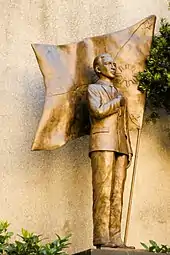
Nicanor Reyes Sr. was the first founding president of the University, which spent its early years establishing several of its institutes, including those of Law and Technology. Reyes Sr. commissioned Architect Pablo S. Antonio Sr., his brother in law and husband of his sister Marina del Rosario Reyes-Antonio, who would later be titled as National Artist under the National Artist of the Philippines awards, to construct the main building for the school. [16] In 1939, the Nicanor B. Reyes Sr. Hall, which would later house the main library at third level and Institute of Accounts, Business and Finance, opened. Two other buildings by Antonio, the Girls’ High School Building and Boys High School Building, followed in 1940 and 1941,[16] by which year FEU had 10,000 registered students, with an international student population of 400.[17][14] Then Philippine President Manuel L. Quezon hailed and called FEU "the best non-sectarian institution in the country."[18]
In 1941, FEU also had the first ROTC quartermaster and ROTC finance units in the Philippines. During the American colonial period FEU ROTC was notable for having the first Coastal Artillery unit in the Philippines. During World War II, FEU cadets fought in Bataan with the Second Infantry Division. FEU constituted the majority of cadets who received armor training. These cadets were trained to operate the American M5 light tank. At the time that the FEU's coast artillery unit was formed, the Philippine Army's Coast Artillery was equipped with the 155mm GPF gun. During the Philippine-American war, the Philippine coast artillery had one 150mm Ordóñez gun. It is said that of all the Philippine colleges whose students and alumni volunteered for military service at the outbreak of the Pacific War in 1941, FEU men formed the greatest number.[19]
In 1942, the Far Eastern University campus was used as a multi-functional facility by the Imperial Japanese Army Transportation Corps. It was later used as the Prisoner of War Bureau for the Japanese Army.
Nicanor B. Reyes Sr. having been killed during the Japanese occupation, Hermengildo B. Reyes was appointed the second president of the University when it reopened in 1945.[20]
The university was re-opened in October 1945 despite the use of most of its facilities by the American forces until their departure in May 1946, the post-liberation years saw the renaissance of FEU with its massive expansion of facilities aimed at meeting the demands of modern and relevant education in the country and the increasing student population. FEU was once named as the “Largest University in Asia”, in the early 1950s when its enrollment passed near 50,000 students.
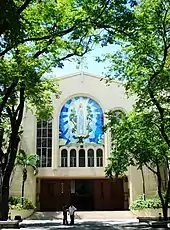
Thereafter, FEU continued to expand, with the opening of the Science Building and the establishment of the Institute of Medicine and the School of Nursing. In 1955, the FEU Hospital was inaugurated. Humanities were introduced in 1959, and in 1970 the Institute of Architecture and Fine Arts opened. Also in 1970, the for-profit status of the Institute of Medicine, School of Medical Technology, FEU Hospital and the Student Health Service Clinic was altered, when these were converted into the Far Eastern University – Nicanor Reyes Medical Foundation, a non-stock, non-profit educational foundation.[14]
In 1989, Nicanor Reyes Jr. introduced substantial revitalization to FEU that took place over a number of years, with renovation and modernization of facilities and grounds and upgrading of the University's educational standard. This resulted in the accreditation of the Institute of Arts and Sciences, the Institute of Education, and the Institute of Accounts, Business and Finance, and, in the mid-1990s, the deregulation of the University by the Commission on Higher Education. The auditorium was upgraded to accommodate modern stage productions and the new twice-monthly presentations by local and international artists established by the President's Committee on Culture. The University also prioritized publication, launching a number of scholarly journals, and began networking with other institutions nationally and abroad.[21]
After careful study of the technology program, the administration in 1992 decided to phase it out in favor of a computer technology program forged with the East Asia Computer Center, Inc. which offered degrees in computer science and certificate courses.[22]
In 2010, FEU established the FEU Makati campus in Makati City, which started its operations by June of the same year. FEU Makati offer master's degree program in Business Administration and Baccalaureate programs in Accountancy, Accounting Technology, Information Technology and Business Administration.[23]
Corporate
The Far Eastern University, Incorporated (PSE: FEU) is a domestic non-sectarian educational institution founded in June 1928 and was registered and incorporated with the Philippine Securities and Exchange Commission on October 27, 1933. On October 27, 1983, the University extended its corporate life to another 50 years. The University became a listed corporation in the PSE on July 11, 1986.[24]
The company operates through three segments: education, real estate and investment activities. Its geographical segments include Manila, Makati and Cavite.[25]
The University's major subsidiaries include: Far Eastern College – Silang, Inc. (FECSI), East Asia Computer Center, Inc. (EACCI), Fern Realty Corporation (FRC), FEU Alabang, Inc. and FEU High School, Inc. Similar to the University, FECSI, EACCI, FEU Alabang, Inc. and FEU High School, Inc. were established to operate as educational institutions offering general courses of study.[23] In April 2016, FEU entered into a share purchase agreement to acquire an initial 80% of Roosevelt College, Inc.[26]
In 2019, FEU has entered into a joint venture with the Technological Institute of the Philippines to launch Edustria, a senior high school in Batangas.[27]
University emblems
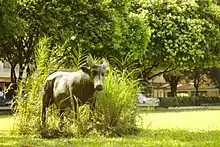
- The University Seal: The FEU Coat of Arms depicts a Sarimanok holding a kalasag. Inside the kalasag is an 8 pointed star that represents the 8 original institutes. (Institute of Accounts, Business and Finance, Institute of Education, Institute of Arts and Sciences, Institute of Technology, Institute of Law, Institute of Medicine, Institute of Nursing and Institute of Graduate Studies) The Sarimanok is housed inside an oblong surrounded with baybayin inspired letters. Under the kalasag is a bamboo scroll inscribed with the baybayin letters “KKK” meaning Kagandahan, Katotohanan at Kalinisan, as suggested by former Institute of Arts and Sciences Dean Alejandro Roces who became National Artist for Literature. The logo was designed by Galo Ocampo, the Father of Philippine Heraldry. He designed the official seal of the Philippine Republic.
- FEU is one of the first universities in the country to be established by a Filipino. Thus, FEU wanted to showcase the Sarimanok-inspired coat of arms; it projects the nationalistic spirit upon which the University was founded. It also serves as the link between the past and present. The Sarimanok is a legendary bird of the Maranao people from Mindanao.[28]
- The University Colors: Gold represents the golden opportunity for the University to serve the youth and her alumni to serve the country. Green is for hope, representing Rizals "Fair hope of the Fatherland.".[29][30]
- The University Font: FEU's official font was inspired by the Baybayin and designed by Galo B. Ocampo.[31]
- The University Mascot: The tamaraw is the mascot of every FEU athletic team. Hence, it is the pet name of every FEU student (Tams). Known scientifically as “Bubalus mindorensis”, it is a rare animal found only in the island of Mindoro. Symbolically enough, the tamaraw is one of the most intelligent, pugnacious and aggressive of our animal species just as the University known for its advanced, progressive policy in contemporary education.[29][32]
- The Nicanor B. Reyes Sr. Memorial Quadrangle is a Manila landmark and a favorite backdrop for picture-taking in the campus. Erected in commemoration of the university’s 40th anniversary, it consists of a 65-foot flagpole on a platform surrounded on all sides with brass sculpture done by National Artist Vicente Manansala which interprets the late founder's philosophy of education.[29] It also represents the professional disciplines offered by the university.[33]
- The University Mace: The Mace is the symbol of the office of the University President.[29]
Manila Campus
FEU's campus is noted for a number of historical Art Deco buildings preserved from the first half of the 20th century.[34] Among the buildings on FEU's campus complex, five by late Ar. Pablo S. Antonio Sr. garnered recognition for FEU in 2005 from the United Nations Educational, Scientific and Cultural Organization (UNESCO), who bestowed the Asia Pacific Heritage Award for Cultural Heritage on the university for "the outstanding preservation of its Art Deco structures."[16]
The buildings include the Nicanor B. Reyes Sr. Hall, the Admissions Building, the Architecture and Fine Arts Building, the Administration Building, and the Science Building. The Cultural Center of the Philippines also recognized the historical legacy of the buildings with a marker. Other historical buildings on the campus include the 1950s FEU Chapel, FEU Hospital, and the Arts and Sciences Building, which also represent the International Style.
The school maintains various facilities, such as an electronic library, various types of laboratories, auditorium, audio-visual and multimedia rooms, technology-based gate security and enrollment system, and gymnasiums.[35]
Due to the FEU's mission to preserve and care for the environment, the university has a green and eco-friendly campus landscape and is famously called as the "Oasis of the University Belt".[36]
| Presidents | |
|---|---|
| Name | Tenure of office |
| Nicanor Reyes Sr. | 1934–1945 |
| Hermenegildo Reyes | 1945–1946 |
| Clemente Q. Uson | 1946–1947 |
| Belen R. Enrile-Gutierrez | 1947–1949 |
| Vidal A. Tan | 1949–1952 |
| Teodoro T. Evangelista Sr. | 1952–1971 |
| Nicanor Mendoza Reyes Jr. | 1971–1982 |
| Belen Reyes Enrile-Gutierrez | 1982–1985 |
| Josephine C. Reyes | 1985–1989 |
| Felixberto C. Sta. Maria | 1989–1995 |
| Edilberto de Jesus | 1995–2002 |
| Lydia B. Echauz | 2002–2012 |
| Michael M. Alba | 2012–present |
| References | [37] |
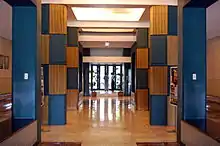
History
During the 1930s, there was a heavy influence of American culture especially in the field of technology and construction that was reflected in the lives of the Filipinos. Concrete and steel were used by the Americans and was found to be the suitable materials for the tropical environment. These were materialized by Arch. Pablo S. Antonio Sr., a National Artist in creating the FEU campus buildings that reflected both the university's and the country's vision and showed his personal transition from Art Deco to the International Style.[16][38] The buildings were constructed between the years 1939 to 1950.

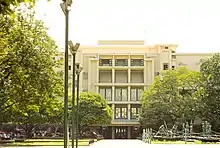
Heritage Buildings of FEU Manila Campus
Nicanor B. Reyes Sr. Hall
The Nicanor B. Reyes Sr. Hall, named after the founder of the FEU, is a long, low-rise U-shaped building facing Quezon Boulevard beside the Alfredo Reyes Hall. The building was constructed in 1939 by National Artist Arch. Pablo Antonio. The distinct character of the massive facade are the sets of protruded vertical volumes located on both ends of the structure.[39]
Attention to details is another design focus of the architecture of Pablo S. Antonio Sr.[38] The heavy influence of Art Deco in his architectural style is seen even in transitional elements like the stairs. The outdoor stairs that joins the walkway at the second floor has layers of thin concrete slabs that swirl in waves above the rigid geometry of the handrail.
The physical envelope of the Main Building, now Nicanor B. Reyes Sr. Hall, is one of the examples of classic Philippine Art Deco emphasizing the play on geometric forms.[38]
Administration Building
The FEU Administration Building was also constructed by Arch. Pablo S. Antonio Sr. a decade after the Nicanor B. Reyes Sr. Hall. It is located at the opposite end of the campus quadrangle that features a facade with geometric architectural details, horizontal windows, and a balcony that extends into a viewing deck at the second floor to observe the activities in the quadrangle. The Administration lobby has floor tiles made of Carrara Marble, the same material used by Michelangelo in his mother and child sculpture La Pieta and also used in New York’s Grand Central Station.
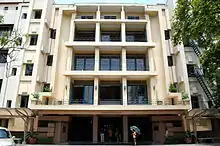
The Art Deco - inspired FEU Theater can be found inside the Administration Building. It also houses the works of the known Filipino artists, most of them in the Art Deco era.[38] One work is a mural done by Antonio Gonzales Dumlao in the Administration Building which conveys the university mission. Francesco Ricardo Monti also did a bas-relief depicting the history of the Philippines.[38]
The former Main Building is one of the twin edifices flanking the Administration Building. It is the third building designed by Arch. Pablo S. Antonio Sr. also in the Art Deco Style. Constructed in 1941, it is used to house the Boys' High School which is originally an early basic education program of the university.
Admissions Building
Built in 1940, the Admissions Building is the mirror image of the Architecture & Fine Arts Building. The building was initially used by the Girls' High School and in 1983 became home to the Institute of Medicine (which now has its own campus in Fairview, Quezon City). In 2015 the building has been renovated and changed its name from FEU-East Asia College Building to the FEU Main Building which was used before by FEU-EAC students. Since there is a newly created building for EAC students they were transferred now to the FEU - Institute of Technology Building located just across the campus in Ricardo Papa street.
Science Building
The seven-story building erected in 1950 was also designed by Arch. Pablo S. Antonio Sr. in what is considered a transition of style between Art Deco and the post World War 2 International Style. In 1990, an earthquake caused structural damages to the building making it necessary to demolish the top two floors. By the late 2013 a sixth floor was added. The building now houses the Department of Medical Technology, Psychology, Biology and Mathematics.[40]
Auditorium
FEU’s Auditorium is designed by Pablo Antonio Sr., National Artist for Architecture in 1949. It is the first Cultural Center of the Philippines, and also, the very first fully air-conditioned auditorium in the Philippines which can accommodate 1000 spectators. The Auditorium was home to renowned orchestras. It featured dances from Manila Ballet Academy, New York City Center Ballet, and Martha Graham – an American dancer and one of the twentieth century revolutionary artists. It also became the venue of major theatrical productions like Bastien and Bastienne – created by two National Artists, Nick Joaquin (on words) and Cesar Legaspi (on scenic designs).
In addition, it was in FEU where Sarah Joaquin–actress, writer, director, and former Head of the Drama Department–showcased her talents through presentation of classic and contemporary plays. To this date, the auditorium upholds this legacy by accommodating more notable performances from artists here and abroad.
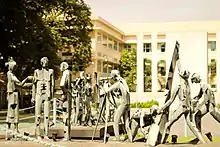

SCA Chapel
Another masterpiece is within the Student Council Association (SCA) Chapel. Inaugurated on the 8th of December 1957, the SCA Chapel is where religious activities of faculty, personnel, and students are held. Its interior features a mural by Carlos “Botong” Francisco, proclaimed National Artist in 1973 and discoverer of Angono Petroglyphs (which is the oldest known work of art in the Philippines). His painting 14 Stations of the Cross encompasses 260 degrees of one’s visual range.[33] SCA Chapel’s façade is the richly colored tile mosaic of Our Lady of Fatima by Vicente Manansala, also a National Artist who developed the transparent cubism technique apparent in this piece of art.
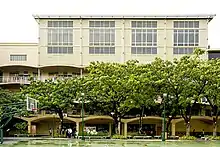
FEU Library
It was located on the first two floors of the Nicanor Reyes Hall. The collection of books falls under Circulation, Reserve, Reference, Filipiniana, and Periodical sections. These can easily be accessed using the OPAC. The Online Public Access Catalog (OPAC) of FEU is its online database of all its print and multi-media resources.[41] The Electronic Library is also available to provide members of the academic community highly effective learning experiences and services through the web and internet technologies as an extension of the services of the conventional library.[42]
The Philippine Association of Academic Research Librarians, Inc. (PAARL) honored the library with the Outstanding Academic/Research Library Award during the PAARL 2012 Awards. The FEU library was recognized for its outstanding contribution to academic and research librarianship and library development along with leadership in regional library management, education and training, information and documentation services.[43]
Academics
Far Eastern University offers 24 undergraduate and 17 graduate degree programs through its seven institutes. The university offers secondary, post-secondary and various certification courses.[44] FEU comprises several Institutes that offer specific programs.[45][26] Starting 2020-2021, FEU Manila will hold extension programs in FEU Cavite[46] Students who wish to study in the university must pass the College Entrance Exam (FEUCAT). The university runs on a semestral academic system. An academic year starts in the second week of August and ends in December.
| Institute founding | |
|---|---|
| Institutes | Year founded |
| Institute of Accounts, Business and Finance | 1929[47] |
| Institute of Arts and Sciences | 1934[48] |
| Institute of Education | 1934[49] |
| Institute of Law | 1934[50] |
| Institute of Technology | 1936[51] |
| Institute of Medicine | 1952[52] |
| Institute of Graduate Studies | 1957[53] |
| Institute of Nursing | 1961[54] |
| Institute of Architecture and Fine Arts | 1970[55] |
| Institute of Tourism and Hotel Management | 2010[56] |
Grading system
An FEU student's final grade for a course generally comes in the form of a letter, which is a summary of his or her performance in the formative and summative assessments. A is given a value of 4, B+ 3.5, B 3, C+ 2.5, C 2, D+ 1.5, D 1, and F 0. The passing mark for all university courses regardless of program is 50%.
Scholarship Grants
FEU funds an average of over 3,500 scholars every year, providing about 11% of the total student population. Scholarships are granted to academically qualified students, financially challenged yet deserving individuals, and university representatives in different fields of service and interests.[57]
Recognition and Accreditation
Conferred the Autonomous University status by Commission on Higher Education (CHED), FEU Manila currently meets the highest regulatory standards set for Philippine HEIs. CHED has designated FEU's Teacher Education Program and Bachelor of Science in Business Administration as Center of Excellence and Center of Development, respectively.[58]
FEU Manila has twenty-one accredited programs. In addition, eight of the undergraduate programs have level 4 – the highest – accreditation from the Philippine Association of Colleges and Universities Commission on Accreditation (PACUCOA), while the rest are on their way to obtaining ever higher accreditation levels.
FEU Manila's international recognitions include being an associate member of the ASEAN University Network – Quality Assurance (AUN-QA), one of less than ten Philippine HEIs with the distinction; a member of the Association to Advance Collegiate Schools of Business (AACSB) for its BS Accountancy, BS Business Administration, and Master of Business Administration programs; and an associate member of the International Centre of Excellence in Tourism and Hospitality Management (THE-ICE) for its BS Tourism Management and BS Hotel and Restaurant Management programs. The Bachelor of Science in Business Administration, Bachelor of Science in Accountancy, Bachelor of Science in Biology and Bachelor of Science in Medical Technology programs are certified by the ASEAN University Network - Quality Assurance (AUN-QA).[59] ITHM’s BS Tourism Management program is also accredited by the Asia-Pacific Institute for Events Management (APIEM) as a Center of Excellence. FEU was the only Philippine school included in the World Universities with Real Impact (WURI) Ranking for 2020, placing 91st in the Global Top 100 Innovative Universities. It also placed 19th on Ethical Value, according to the WURI ranking system.[60]
International certification/accreditation
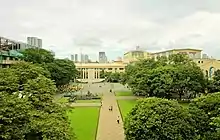
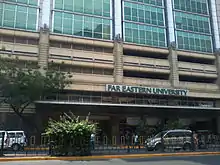
The university received an ISO 9000:2008 for Quality Management and became one of the pilot university in assessment by IQUAME.
- Associate Status with the International Centre of Excellence in Tourism and Hospitality Education
- Member of the Pacific Asia Travel Association (Philippine Chapter)
- Member of the Association to Advance Collegiate Schools of Business
- Associate Member of the ASEAN University Network Quality Assurance
- Center for Excellence by the Asia Pacific Institute for Events Management International
- Accredited by the Association of Chartered Certified Accountants
Local
In 2012, Far Eastern University was granted Autonomous Status by the Commission on Higher Education (CHED).[61] FEU has twenty-one accredited programs by the Philippine Association of Colleges and Universities Commission on Accreditation (PACUCOA) and Philippine Accrediting Association of Schools, Colleges and Universities (PAASCU).
- PACUCOA Level IV Accredited programs: Accountancy, Applied Mathematics with Information Technology, Biology, Business Administration, Communication, Elementary Education, Secondary Education, Psychology
- PACUCOA Level III Accredited programs: Doctor of Education, Master of Arts in Education, and Master of Arts in Psychology
- PACUCOA Level II Accredited programs: English Language, Literature, Political Science, Hotel and Restaurant Management, Architecture, Fine Arts, International Studies, Medical Technology
- PAASCU Level III Accredited program: Bachelor of Science in Nursing[62]
Research Centers and auxiliary units
FEU funds research in areas such as biodiversity, urban renewal, public health, genetics, sociolinguistics, and indigenous cultures.[63] The University, through the representation of the URC, has been an active member of the Metro Manila Health Research and Development Consortium (MMHRDC) and the University belt Consortium (U-Belt Consortium).[64]
- FEU Public Policy Center - is a private research foundation which aims to make a substantive contribution to evidence-based policymaking through in-depth research and public discussion. [65]
- Center for Studies on the Urban Environment (SURE) - created in response to continuing degradation of the urban environment most especially in the inner cities. As its initial major project, the Center organized in November 2000 the "International Conference on Megacities in the 21st Century," It gathered speakers from Asian and Western Countries who shared their knowledge and experience in Urban renewal and development.
- FEU Center for Continuing Education - it serves as the university’s arm for conducting relevant trainings and programs for non-FEU students and professionals.
- FEU Innovation Center - will serve as a think-tank and incubation center for business ideas.
- FEU Community Extension Services (CES)[66]
- Center for Teaching and Learning (CTL)[67]
- Center for Learning Enrichment & Research for Students
- Language Learning Center[68]
- University Research Center (URC) - a university-based research and extension unit that aims to foster a culture of research in the university. The URC facilitates the production of research through funding, research capability-building, research information dissemination, linkages and publication.
- FEU Herbarium
- FEU-DENR-WWF Tams2
Publications
Key Institutional Materials and University Publications
- Annual Report
- President's Report
- TAMBULI - the official publication of Far Eastern University.[69]
- The FEU Advocate - the official student publication of FEU Manila, established in 1934.[70]
- Asian Journal on Perspectives in Education - is an open access, multidisciplinary, and double-blind peer-reviewed international journal. A flagship project of IE.[71]
- Asia Pacific Urban Journal
- Paragon - the official student publication of IAS.[72]
- Circle Arts and Design Magazine - the official publication of IARFA, which showcases the art projects of its students.[73]
- The Lamp - the official student publication of IN.
Student Life
FEU has had long and rich history in education, culture, arts and sports. [74]
Athletics
FEU is a founding member of the two major collegiate athletic organizations in the Philippines, namely the National Collegiate Athletic Association (NCAA) and the University Athletic Association of the Philippines (UAAP).[75]

Among the many athletes who have attended FEU are Alberto Nogar Sr, Lydia De Vega, Elma Muros, Anthony Villanueva, and Johnny Abarrientos.[76] FEU's teams are named after the tamaraw, a buffalo with a reputation for ferocity.[77]
Events
Musica FEUROPA - is an annual national choral competition in partnership with the European Union (EU) organized by the FEU Chorale and the President's Committee on Culture.
Tatak Tamaraw - is a week long event that welcomes freshmen to the FEU community. It also orients them on policies, support services, and the vibrant campus life.
Tam Rally - parade and performances by FEU Athletes and Cultural Groups.
Tam Hunt, a student[78] organizations membership fair.
Concierto Piyu, a concert held during foundation day.
Paskong Piyu - university-wide Christmas celebration and inter-institute sing and dance competition.
CreePIYU - an annual halloween event.[79]
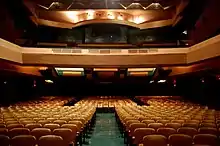
Arts and culture
Since 1990, the university has maintained the FEU Center for the Arts (formerly known as President's Committee on Culture)[80] which programs a year-long calendar of cultural activities. The FCA also nurtures seven cultural groups namely, FEU Bamboo band, FEU Chorale, FEU Dance Company, FEU Drum and Bugle Corps, FEU Theater Guild, FEU Drummers and the FEU Guides. The FEU Guides conduct tours of FEU's UNESCO awarded campus.
FEU was the first university in the Philippines that allowed students to dress up according to their gender identity.[81] In August 2016, the university started to relax its dress code and allowed students to dress according to one's gender. [82] The students can enjoy all-gender restrooms, "a no-haircut policy", school attire options instead of a uniform, and a multi-faith room.[83]
Student organizations and core groups
There are 58 student organizations under the supervision of the Office of Student Affairs, which serves as the arms of Student Development, Guidance & Counseling, FEU Center for the Arts, Institutes, and Departments of degree programs in providing out-of-the-classroom experiences for the students to make them holistically formed. The organizations usually conduct projects during the Activity Period.[84]
FEU Central Student Organization is the central student government of the Far Eastern University, which promotes student rights and well being and at the same time develop programs and activities that will cater the needs of the student body inside or outside the university.[78]
Volunteerism
The university participates in Hands on Manila's yearly Servathon, an event that helps marginalized sectors through volunteer service.[85]
FEU Group of Schools
The FEU System is composed of six legal entities, 10 campuses, and over 40,000 students.
| Far Eastern University (FEU Manila) |
|
FEU Manila is the main and flagship campus of Far Eastern University, it is located at Nicanor Reyes Street, Sampaloc, Manila, Philippines. | [86] |
| Far Eastern University Makati (FEU Makati) |
|
FEU Makati is a satellite campus located in the business district of Makati, Philippines. The school primarily serves the university's graduate business and law students. | [87] |
| Far Eastern University Institute of Technology (FEU Tech) |
|
FEU Tech is the engineering and technology unit of the university located at P. Paredes St., Sampaloc, Manila, just a minute walk from the main campus. | [88] |
| Far Eastern University Diliman (FEU Diliman) |
|
FEU Diliman is located in Diliman, Quezon City. It is the largest FEU campus to date and houses the FEU Sports Center. | [89] |
| Far Eastern University Alabang (FEU Alabang) |
|
FEU Alabang is an extension campus of FEU Tech located at Corporate Woods, Filinvest City, Muntinlupa, Philippines. | [90] |
| Far Eastern University Roosevelt (FEU Roosevelt) |
|
FEU Roosevelt is a private non-sectarian college system of five greater Metro Manila campuses. It currently operates a three sub-campuses located in Cainta, Marikina, and Rodriguez. | [91] |
| Far Eastern College – Silang (FEU Cavite) |
|
FEU Cavite is an extension campus of FEU Manila located at MetroGate Silang Estates, Silang, Cavite, Philippines. | [92] |
| Far Eastern University High School (FEU High School) |
|
FEU High School offers senior high school program with strands (STEM, ABM, HUMSS, GAS). | [93] |
| Far Eastern University – Nicanor Reyes Medical Foundation (FEU NRMF) |
|
FEU NRMF is the medical school of Far Eastern University; FEU NRMF administration is highly autonomous and independent from FEU Manila. It is located at Regalado Avenue, West Fairview, Quezon City. | [94] |
Notable alumni
Prominent graduates from Far Eastern University include celebrities, politicians, business people, athletes and more. Anthony Villanueva (boxing), Felicisimo Ampon (tennis), Lydia De Vega (track and field), Johnny Abarrientos (basketball), Rachel Daquis (volleyball), and Janelle Frayna (chess) -- all FEU international athletes.
References
- Charm, Neil. "FEU swings to loss on enrollment decline, tuition discounts | BusinessWorld". Retrieved 2020-11-18.
- "The Story of FEU • Far Eastern University". Far Eastern University. Retrieved 2020-06-02.
- "'FEUture' accountants describe the victory". Inquirer Lifestyle. 2015-08-07. Retrieved 2019-08-06.
- "Academic Institutes • Far Eastern University". Far Eastern University. Retrieved 2020-08-06.
- Oct 18, Sasha Lim Uy |; 2017 (18 October 2017). "Where Did the Richest Filipinos Go to School?". Esquiremag.ph. Retrieved 2019-08-06.CS1 maint: numeric names: authors list (link)
- Charm, Neil. "SC's Martires tops Ombudsman shortlist | BusinessWorld". Retrieved 2019-08-06.
- bw_mark. "Developer KMV Asia focuses on environment-friendly projects | BusinessWorld". Retrieved 2019-08-06.
- Mendoza, Al S. (2018-07-05). "FEU fetes its greatest alumnus of all time - Al S. Mendoza". BusinessMirror. Retrieved 2019-08-06.
- "Digital doctor". The Manila Times. Retrieved 2019-08-06.
- "List Of Board Top Notchers". FEU Alumni.
- "Jamela Alindogan". www.aljazeera.com. Retrieved 2019-08-06.
- Rüegg, Walter (2004). Universities in the nineteenth and early twentieth centuries (1800-1945). A History of the University in Europe. 3. Cambridge University Press. p. 213. ISBN 0-521-36107-9.
- Gupit Jr., Dr. Fortunato, ed. (1986). Elements of Public Speaking (4th ed.). Rex Bookstore. p. 340. ISBN 971-23-0415-9.
- "The History of FEU". feu.edu.ph. Archived from the original on 2007-06-09. Retrieved 2009-09-10.
- "History of the far Eastern University". feuhighschool82.rpg-board.net. Retrieved 2020-03-16.
- Ortiz, Margaux (2007-01-15). "Art Deco buildings thrive on FEU campus". Philippine Daily Inquirer. Archived from the original on 2012-10-12. Retrieved 2009-09-10.
- de Jesus, Edilberto C. (2002). "Muddling Through: Development Under a "Weak" State". In Wan-Ling Wee, C.J. (ed.). Local cultures and the "new Asia": the state, culture, and capitalism in Southeast Asia. Social Issues in Southeast Asia Series. 24. Institute of Southeast Asian Studies. p. 70. ISBN 981-230-123-2.
- "Be Brave: The Story of Far Eastern University - YouTube". www.youtube.com. Retrieved 2020-08-02.
- "BRIEFER: Guerrillas in the Battle of Manila | Presidential Museum and Library". Retrieved 2020-09-05.
- "The History of FEU". feu.edu.ph. Archived from the original on 2007-06-09. Retrieved 2009-09-10.
- "BIOTA Newsletter 2013" (PDF). BIOTA Newsletter. 15: 14. April 2013.
- "History of the far Eastern University". feuhighschool82.rpg-board.net. Retrieved 2020-03-16.
- "FEU Investor Relations". investors.feu.edu.ph. Retrieved 2019-08-08.
- "Company Information". edge.pse.com.ph. Retrieved 2019-08-06.
- Editorial, Reuters. "FEU.PS - Far Eastern University Profile | Reuters". www.reuters.comundefined. Retrieved 2019-12-30.
- "Company Information". edge.pse.com.ph. Retrieved 2019-09-17.
- "Far Eastern University – APEA – Asia Pacific Entrepreneurship Awards". Retrieved 2019-12-30.
- "Edukasyon.ph: Apply to Colleges & Senior High Schools Online". portal.edukasyon.ph. Retrieved 2020-05-13.
- IABF Bulletin of Information 2005-2007
- FEU Publication
- name="feu publication"
- The FEU Advocate - University Profile
- Aguilar, Karl (June 3, 2010). "A journey to the abode of the Tamaraws". The Urban Roamer. Retrieved July 24, 2019.
- Generalao, Minerva; Villa, Kathleen de. "Structural marvels of learning". Retrieved 2019-08-06.
- Editorial, Reuters. "FEU.PS - Far Eastern University Profile | Reuters". www.reuters.comundefined. Retrieved 2019-12-30.
- Soliven, Preciosa (2006). "FEU UNESCO HERITAGE OASIS". PhilStar.
- "Far Eastern University Presidents". Far Eastern University. Retrieved December 12, 2020.
- Montinola, Lourdes (2010). Art Deco in the Philippines. Manila: ArtPositAsia. ISBN 978-971-057-905-1.
- Villa, Minerva Generalao and Kathleen de. "Structural marvels of learning". business.inquirer.net. Retrieved 2020-05-13.
- Villa, Minerva Generalao and Kathleen de. "Structural marvels of learning". business.inquirer.net. Retrieved 2019-08-06.
- "Library | FEU Alabang". Retrieved 2019-08-07.
- "Destiny OPAC". FEU LIBRARY. 2015-09-18. Retrieved 2019-08-07.
- "PressReader.com - Your favorite newspapers and magazines". www.pressreader.com. Retrieved 2019-08-07.
- "FEU:Philippines Stock Quote - Far Eastern University Inc - Bloomberg Markets". Bloomberg.com. Retrieved 2019-09-17.
- University, Far Eastern. "Far Eastern University". Far Eastern University. Retrieved 31 January 2020.
- "Degree Programs • Far Eastern University". Far Eastern University. Retrieved 2020-07-22.
- "Institute of Accounts, Business, and Finance • Far Eastern University". Far Eastern University. Retrieved 2020-11-09.
- "Institute of Arts and Sciences • Far Eastern University". Far Eastern University. Retrieved 2020-11-09.
- "Institute of Education • Far Eastern University". Far Eastern University. Retrieved 2020-11-09.
- "Institute of Law • Far Eastern University". Far Eastern University. Retrieved 2020-11-09.
- "FEU Institute of Technology". www.feutech.edu.ph. Retrieved 2020-11-09.
- "History | FEU-NRMF". www.feu-nrmf.ph. Retrieved 2020-11-09.
- University, Far Eastern. "Far Eastern University". Far Eastern University. Retrieved 2020-11-09.
- "Institute of Nursing • Far Eastern University". Far Eastern University. Retrieved 2020-11-09.
- "Institute of Architecture and Fine Arts • Far Eastern University". Far Eastern University. Retrieved 2020-11-09.
- "Institute of Tourism and Hotel Management • Far Eastern University". Far Eastern University. Retrieved 2020-11-09.
- "Scholarship Grants • Far Eastern University". Far Eastern University. Retrieved 2020-06-12.
- "2 programs declared as Center of Excellence, Development".
- "Four FEU programs gain AUN-QA certification • Far Eastern University". Far Eastern University. 2021-01-28. Retrieved 2021-01-28.
- News, ABS-CBN (2020-09-24). "FEU makes it to innovative universities global list; Stanford, MIT 1-2". ABS-CBN News. Retrieved 2020-09-25.
- "Autonomous Status".
- "Awards and Citations".
- "Choose To Be Brave Campaign". FEUAlumniStore. Retrieved 2020-06-12.
- "University Research Center • Far Eastern University". Far Eastern University. Retrieved 2020-11-29.
- "FEU Public Policy Center – FEU Institute of Law". Retrieved 2020-10-10.
- "Community Extension Services (CES) • Far Eastern University". Far Eastern University. Retrieved 2020-10-28.
- "Center for Teaching and Learning (CTL) • Far Eastern University". Far Eastern University. Retrieved 2020-10-28.
- "Language Learning Center • Far Eastern University". Far Eastern University. Retrieved 2020-10-28.
- University, Far Eastern (1900). Tambuli : the official publication of Far Eastern University. Manila, Philippines : Far Eastern University.
- "FEU Advocate - The Official Student Publication of Far Eastern University-Manila". feuadvocate.net. Retrieved 2020-04-16.
- "Asian Journal on Perspectives in Education • Far Eastern University". Far Eastern University. Retrieved 2020-07-18.
- "IAS Paragon". www.facebook.com. Retrieved 2020-04-16.
- "Circle Art and Design Magazine". www.facebook.com. Retrieved 2020-04-16.
- "Far Eastern University (FEU) | Devex". www.devex.com. Retrieved 2020-05-18.
- "FEU - Claverianosclan". sites.google.com. Retrieved 2020-05-26.
- University, FarEastern. "FEU Green & Gold Awards". www.feu.edu.ph. Retrieved 2018-08-03.
- "Story Map Journal". www.arcgis.com. Retrieved 2020-10-18.
- "FEU Central Student Organization". www.facebook.com. Retrieved 2019-08-08.
- "FEU's Creepiyu IV: Thrilling, terrifying—and informative". Inquirer Lifestyle. 2019-11-01. Retrieved 2020-11-09.
- "Far Eastern University". www.facebook.com. Retrieved 2020-06-12.
- "Roman hails FEU community's 'inclusive hearts'".
- "Inclusivity programs". Archived from the original on 2018-12-07.
- "FEU recognized for corporate governance, student services". 16 September 2019.
- "Far Eastern University (Fees & Reviews): Manila, Philippines". edarabia.com. Retrieved 2020-04-17.
- "FEU | An Inclusive and Welcoming Environment for Students". Archived from the original on 2018-12-07.
- University, Far Eastern. "Far Eastern University". Far Eastern University. Retrieved 2020-07-10.
- "FEU Makati | Far Eastern University". www.feu.edu.ph. Retrieved 2018-07-31.
- "IT & Engineering School in Philippines - FEU Tech". Retrieved 2020-04-16.
- "FEU Diliman | Transforming Lives". Retrieved 2020-05-21.
- "College and Senior High - FEU Alabang".
- "FEU Roosevelt". FEU Roosevelt. Retrieved 2020-07-10.
- "Archived copy". Archived from the original on 2015-05-10. Retrieved 2015-05-27.CS1 maint: archived copy as title (link)
- "FEU High School - Future Ready Learning".
- "Far Eastern University - Nicanor Reyes Medical Foundation - Institute of Medicine". www.feu-nrmf.ph. Retrieved 2020-04-16.
